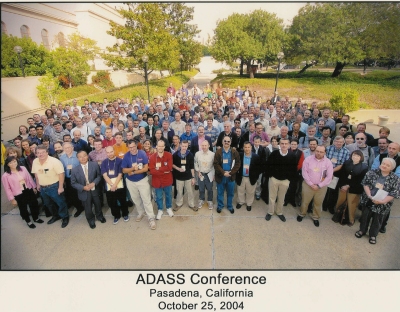Summary of the Astronomical Data Analysis Software and Systems XIV conference
1 November 2004
ADASS XIV Pasadena, California, USA24-27 October 2004The fourteenth Astronomical Data Analysis Software and Systems conference got off to a warm start here in Pasadena, southern California with a backdrop of hills surrounding the Los Angeles greater area. The conference, which for the past fourteen years has concentrated on the development of analysis and archiving tools for all major astronomical observatories and space missions, has evolved into a major annual forum for scientists and programmers concerned with algorithms, software and software systems employed in the acquisition, reduction, analysis, and dissemination of astronomical data. An important element of the program is to foster communication between developers and users with a range of expertise in the production and use of software and systems. The programme consists of invited talks, contributed oral and posters, tutorials, user group meetings and special interest group meetings called Birds of Feather (BOFs.)
Emerging groups involved in these activities include the European Virtual Observatory (EU), the National Virtual Observatory (USA), the International Virtual Observatory Alliance, which includes all VO organisations from India, Europe, USA, Canada and Japan and Russia. In addition, representatives from ESA and NASA science missions regularly take part to ensure compatibility with all archive groups presently and in the future. A total of about 290 participants took part this year.
The conference year was opened by George Helou, director of the Infrared Processing and Analysis Center (IPAC), which belongs to the California Institute of Technology (Caltech) and host to ADASS XIV. Key speeches were also given by David Baltimore (president of Caltech) and Larry Simmons (Directorate of Astronomy and Physics at JPL.)
In the individual parallel sessions, a meeting on the astronomical FITS standard took place. In particular, new extensions are being proposed in order to accommodate the new 64 bit architecture as well as the work being done on multiple papers covering the definition of World Coordinate Systems. This was organised by Bill Pence.
Multiple talks and poster sessions covered the important field of the Virtual Observatory and Grid processing during the conference.
- Julio Valdes (NRC-CANADA) presented a very original approach to "project" a multivariate universe into a 3D virtual space, allowing intelligent resource discoveries.
- Gabriel (ESA) summarised activities in XMM-Newton operations for the past five years and presented impressive results of the mission.
- Ansari (ESA) presented an interesting project using Grid technologies to distribute the data processing of the forthcoming GAIA mission.
- Padovani (ESO) presented the first scientific results from a research accomplished using the AVO prototype.
- Ochsenbein discussed the Aladin experience. Born 8 years ago, Aladin is now a standard VO tool allowing display of images and associated catalogues.
- Osuna (ESA) demonstrated the latest version of VOSpec, a tool which will do to spectra what Aladin does for astronomical images.
- Deelman (Caltech) discussed the usage of the grid tools in order to support large-scale astronomy applications. Examples using montage were discussed.
- Linde (University of Leicaster) presented the multiple features of AstroGrid and its relevance to the Virtual Observatory concept. An important release was announced for Decembre 2004.
- Another talk on the same subject was presented by Walton (University of Cambridge) in putting emphasis on scientific applications.
- Garder (Pittsburgh Supercomputing Center) made an analysis of parallel data analysis using the Grid.
- Plante (NCSA) presented the VO registry architecture with an invitation to publish all known services to the VO.
- O'Mullane (Johns Hopkins University) showed the OpenSkyQuery and OpenSkyNode systems for the VO using the new VO standard ADQL.
- Giaretta (Starlink/RAL) discussed the ways one would VO-enable existing astronomical analysis and reduction software.
- Finally, Devereux presented a clever algorithm for catalogue cross matching.
The Virtual Observatory was also the main topic for multiple poster presentations. To name a few:
| Arviset (ESA) |
European Space Based Astronomy through the VO |
| Colberg (University of Pittsburgh) |
Integrating legacy code into the VO |
| Conti (STScI) |
GALEX services for the VO |
| Kamp (STScI) |
MultiMission Archive at STScI in the context of the VO |
| Leoni (ESO) |
A nice summary of the multiple VO tools available |
| Mann (University of Edinburgh) |
XML language in the VO |
| McDowell (Smithsonian Astrophysical Observatory) |
Spectral Energy Distribution data model for the VO |
| Nieto-Santisteban (Johns Hopkins University) |
The importance of Database systems for the VO and the Grid |
| Raddick (John Hopkins University) |
Education using the Virtual Observatory |
| Sawada (Nobeyama Radio Observatory) |
Development of a virtual Observatory for ALMA |
| Sforna (ESA) |
Development of a layer to enable the ESO/ST-ECF archives to be VO compliant |
| Tanaka (NOAJ) |
The Japanese Virtual Observatory prototype |
| Graham (Caltech) |
A distributed statistical toolkit for the VO |
| Benson (Mullard Space Science Laboratory) |
The usage of the registry and the AstroGrid |
| Hesselroth (Spitzer Space Science) |
Development of a Java thick client user interface for Grid processing |
| Jacob (JPL) |
Grist, a new tool for data mining in Astronomy |
| Vuerli (INAF-O.A. Trieste) |
Grid-related activities at INAF |
The next ADASS Conference will be hosted for the first time by ESA at the European Space Astronomical Centre (ESAC) in Villafranca, Spain between 2nd and 5th October, 2005.
D. Durand (NRC - Canada)
S. Ansari (ESA)
 |

